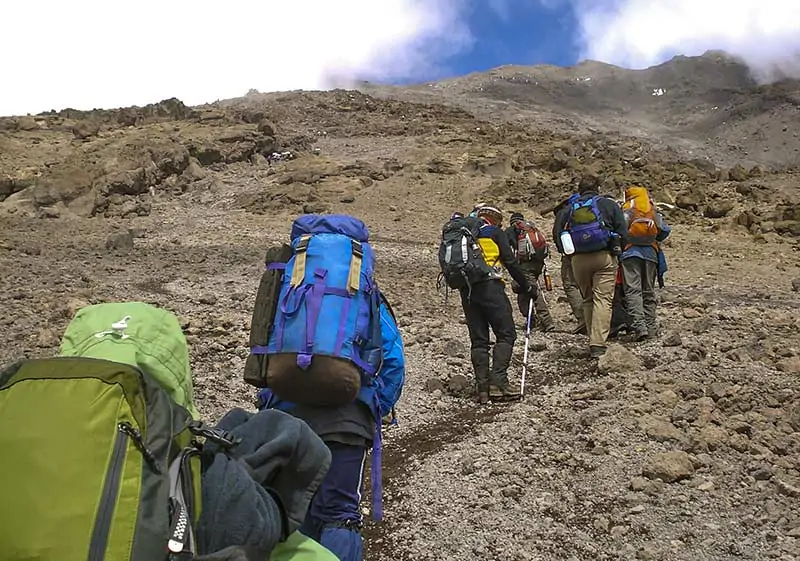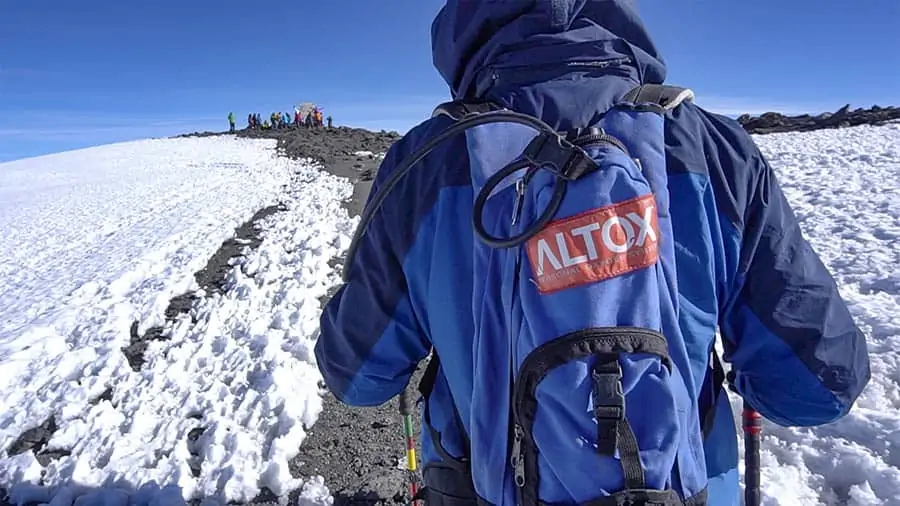Do you have what it takes to reach the top of Mount Kilimanjaro?
Though impossible to know for sure till your trials on the mountain begin, the odds are already working in your favor. Kilimanjaro requires absolutely no technical climbing expertise. Years of hiking and backpacking are not requisite to successfully tackling the highest freestanding mountain in the world! Many first-time hikers do well on this adventure. People ranging from age 6 to 89 have found their moment of glory atop Uhuru Peak.
Approximately two out of every three attempts are successful. Yet Kilimanjaro has also bested some of the most renowned professional athletes in the world, such as tennis great Martina Navratilova and Super Bowl champion Ray Lewis.
So what exactly makes this mountain difficult to climb?
Your Biggest Obstacle

Most people think that climbing a tall mountain is difficult due to the physical endurance needed to take thousands of steps on an inclined slope. Though physical preparedness is a crucial component to conquering Kili, it is only one of many. While the energy needed to ascend is significant, it is most likely not the reason why an individual would fail to summit.
Acute mountain sickness (AMS), also referred to as altitude sickness, is the real opponent. It is caused by the lack of oxygen at high altitude. For most people, at 8,000 feet above sea level and higher, symptoms can occur.
Milder cases of AMS include symptoms such dizziness, nausea, shortness of breath, headaches, and general fatigue. It is very common to experience mild symptoms of AMS while climbing Kilimanjaro. Symptoms typically will subside by spending more time on the mountain near the same elevations. However, there are those who do not acclimatize well and symptoms worsen with time and at greater elevations.
Moderate AMS symptoms may include diminished sleep, loss of appetite, swelling of hands and feet, and even vomiting. In the most severe cases of AMS, high altitude cerebral edema (HACE) and high altitude pulmonary edema (HAPE) can occur, and these conditions require immediate attention.
What Factors Increase the Incidence Rate of AMS?
The incidence rate of altitude sickness depends on various factors, including an individual’s age, gender, rate of ascent, fitness and health, previous experience at altitude, and their genetic susceptibility to altitude sickness.
It’s Written in Your Genes

The most determinant factor is sadly the one which you have the least amount of control – your genetics. It has been known that some people are inherently more susceptible to altitude sickness than others. Studies conducted over the past decade have revealed a genetic predisposition to AMS.
One such study done by Robert Roach discovered six genes whose expression (or lack thereof) can predict susceptibility to AMS with up to 95% accuracy.
Caution for Young, Strong Guys

One study indicated that younger people might be at higher risk, reporting that individuals who were 18 to 19 years of age had an incidence rate of 45%, while individuals between 60 and 87 years of age only reported a 16% incidence rate. However, the results may be explained away by the higher exercise intensity of younger people as rigorous exercise can cause AMS.
Some report that men have a slightly higher risk than females. But this may also be due to exercising at a more strenuous pace. The risk of developing altitude sickness between the genders is believed to be equal.
The lesson here is to take it very easy on Kilimanjaro no matter who you are. Don’t trudge ahead just because you can.
Take it Slow and Steady

AMS occurs when the body cannot adjust fast enough to the decreasing oxygen level. Therefore, a slow rate of ascent is recommended. Fortunately, this is not something that a climber has to figure out on a guided Kilimanjaro trek once the route has been selected.
The expert guides at Peak Planet control the pace based on their experience with thousands of clients. The elevation gain, the number of breaks, and the camp locations have been tested to increase the safety and success of the climb.
Several trekking routes and durations are available through Peak Planet, ranging from 6 days to 10 days on the mountain. A longer route is always recommended to slow down the rate of ascent. The added time gives the body a better chance of acclimatizing to the altitude. That is why the longer routes have a greater probability for success (as high as 95%) and lesser incidence of severe AMS.
Good Fitness isn’t Foolproof

It is logical that people who are fit have an advantage in acclimatizing over those who in poor health. But the research does not prove this. In fact, tests have shown that physically fit individuals fall victim to altitude sickness at the same rate as those less fit. But don’t take this to mean that training isn’t necessary. Being in good shape means your body does not have to use as much energy to recover from activity and instead use its resources to cope with the altitude.
Peak Planet advises no less than 12 weeks of consistent training leading up to your climb. Though no one plan is one-size-fits-all, it should be understood that you should spend as much time on your feet as possible. Walk, walk, and walk some more, and do so outside the coziness of a gym and, if possible, outside hours you would normally operate so your body gets used to performing under adverse conditions and with little rest.
You should be able to tolerate, with relative ease, 10-15 miles of walking in a day with minimal stops. Building this level of muscular endurance is crucial, as crippling fatigue on summit night will fight you every step of the way. Destroy any notion of a comfort zone as you train, because Kilimanjaro requires it.
Those with pre-existing diseases such as heart and lung conditions should show extra caution when considering ascents to altitude.
Get Up High

If the option is available prior to your climb, spend time at altitude to see how your body reacts.
People who live at sea-level are more susceptible to AMS than those who normally live at higher elevations. If you have been to high altitudes before without experiencing any symptoms of AMS, you are less likely to have problems at altitude in the future. Those who have had a recent exposure to altitude are less likely to develop AMS.
One clever way if boosting your success rate is to lower the mountain so to speak, by increasing the oxygen available to your body. How? Peak Planet offers rental of personal oxygen systems. Should you have doubts about your ability to acclimatize, these systems provide pulses of oxygen as you inhale which can help improve your athletic performance and reduce the likelihood of AMS.
Another way of increasing your oxygen intake is through a medication called Diamox (Acetazolamide). This medication increases your respiration rate, which in turn brings more oxygen into the body through more frequent inhalation. Diamox is typically taken for the duration of the climb and has been shown to prevent and treat AMS.
The Mental Game

Let’s be clear. You can’t out tough AMS.
AMS is a physical condition that cannot be tamed with your mind. If your symptoms are more than mild, it is time to consider turning around. There is no shame in getting sick.
However, barring altitude sickness or injury, a strong mental game can keep you going in those moments on the mountain when physical and emotional exhaustion and harsh alpine conditions put up a proverbial wall. It’s at these moments where the time you spent in the gym are of little use, and you must rely on resiliency to regain your composure.
Meditation is a fantastic tool to have at your disposal, and you don’t need to be an expert enjoy its benefits. Meditation can decrease physical and emotional tension, calm your breathing as you struggle at high altitude, and may even help you find precious hours of sleep when your body has other ideas. There are countless anxiety-reduction and mindful-breathing meditation videos available online.
In Summation
If you have the desire to achieve something as monumental as a Mt. Kilimanjaro summit, and the drive and discipline to follow through with your physical and mental preparation, you’re off and running. Whether you have years of hiking and climbing experience or not, Kilimanjaro is still within your reach.
The largest and most common hurdle is overcoming symptoms of AMS and fighting through those moments when the mountain asks you if you’re sure.
AMS is caused by a variety of factors. Some of which are in your control and some of which that are not. Make good decisions about the things you can control, such as route choice, being fit, using an oxygen system and taking Diamox. And leave it to the Universe decide the outcome.
Your decision to trek with Peak Planet puts you in the hands of the best guides in the business. Many of them, when asked, will be delighted to tell you how many times they’ve climbed Kilimanjaro if they haven’t lost track. Utilize their extensive level of expertise and breadth of experience to your advantage. They are there to coach you through those precarious moments and they are exceptionally good at it. From those that assist in the planning phase to the guides and porters you’ll share this once-in-a-lifetime experience with, rest assured your biggest concern will be putting one foot in front of the other until you reach the top.


